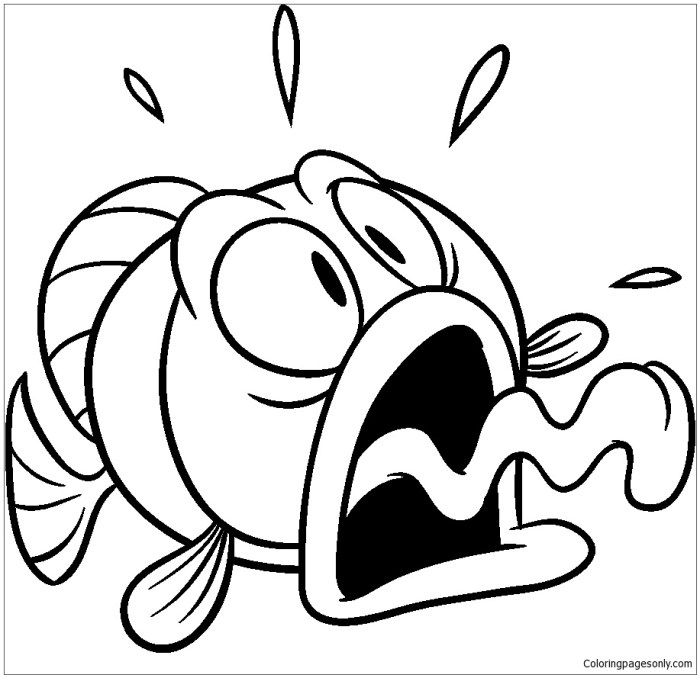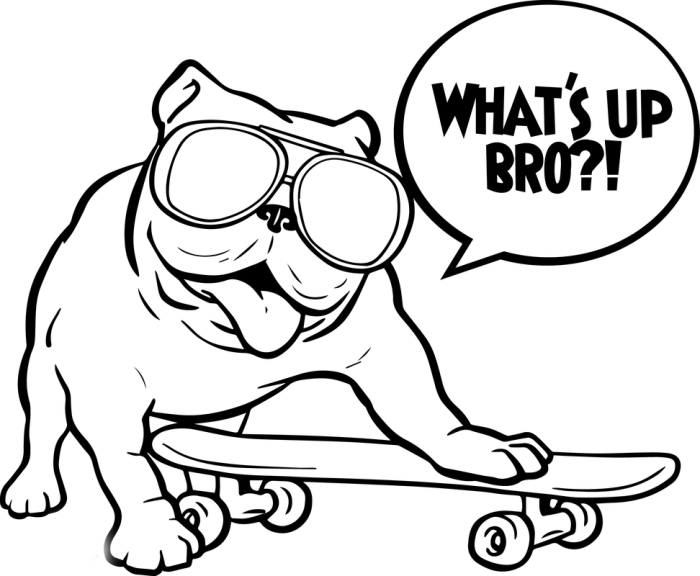Target Audience Identification
Coloring pages funny animals – Identifying the ideal audience for funny animal coloring pages is crucial for effective marketing and design. Understanding their age, interests, and emotional responses helps create engaging and appealing content. The primary audience for these coloring pages is children, but the specific age range and preferences vary.The core target audience for funny animal coloring pages is children aged 3 to 8 years old.
This age group possesses the fine motor skills necessary for coloring and a strong interest in animals, especially those presented in a playful or humorous manner. They are at a developmental stage where imaginative play and creative expression are highly valued. This age range also corresponds to a period of significant cognitive and emotional development.
Characteristics of the Target Audience
Children in this age range generally enjoy bright colors, simple designs, and easily recognizable animal characters. They are drawn to humor and silliness, often finding amusement in exaggerated features or silly situations. Their preferences extend beyond simply coloring; they often incorporate storytelling, imaginative play, and social interaction into their coloring activities. For example, a child might create a narrative around their colored picture of a giggling hippopotamus, involving other toy animals or friends.
Their attention spans are generally shorter, so the coloring pages should be engaging enough to maintain their interest but not overly complex or time-consuming.
Emotional Response to Funny Animal Coloring Pages
Funny animal coloring pages evoke positive emotions in young children. The playful nature of the animals and the creative act of coloring combine to stimulate feelings of joy, happiness, and satisfaction. The act of coloring itself can be calming and therapeutic, providing a sense of accomplishment and self-expression. Seeing their finished artwork, especially one featuring a humorous animal, can boost their self-esteem and confidence.
Unleash your inner artist with coloring pages of funny animals! Their whimsical designs are a great way to de-stress, but did you know the intricate beauty of nature extends to the microscopic level? For a fascinating educational twist, check out this amazing animal cell coloring page and discover the wonders within! Then, jump back to those hilarious animal faces and let your creativity run wild.
It’s all about exploring the fun and fascinating worlds around us, one color at a time.
For instance, a child might proudly show off their completed coloring page of a silly monkey to their parents or friends, eliciting positive feedback and reinforcing their creative efforts. The vibrant colors and amusing imagery further contribute to a positive and uplifting experience.
Illustrative Techniques & Styles: Coloring Pages Funny Animals

Choosing the right illustrative technique is crucial for creating engaging and appealing funny animal coloring pages. The style you select will greatly impact the overall look and feel, influencing how children perceive the animals and their personalities. We’ll explore three distinct techniques: line art, watercolor, and digital painting, highlighting their strengths and how they can be applied to create humorous animal characters.
Line Art for Funny Animal Coloring Pages
Line art is a classic and versatile technique perfectly suited for coloring pages. Its simplicity allows for clear Artikels and easy coloring, making it ideal for younger children. Line weight plays a significant role in conveying personality. Thicker lines can create a bold, playful look, while thinner lines can produce a more delicate and whimsical feel. For example, a cartoonish bear with thick, uneven lines might appear clumsy and endearing, while a fox with thin, precise lines could be portrayed as sly and cunning.
Adding details like expressive eyes and exaggerated features further enhances the humor. Imagine a mischievous monkey with comically oversized ears and a wide grin, depicted with varying line weights to emphasize these humorous aspects. The contrast between thick lines for the body and thin lines for the details helps to create a balanced and appealing design.
Watercolor for Funny Animal Coloring Pages
Watercolor offers a softer, more expressive approach compared to line art. The fluidity of the medium allows for subtle shading and blending, creating a sense of depth and dimension. Line work is still important in watercolor, providing structure and defining the animal’s form, but the emphasis shifts to the color and texture. A playful penguin could be depicted with light washes of blue and white, creating a fluffy, almost cartoonish appearance.
Using darker washes around the eyes and beak can add depth and personality. The lack of harsh lines in watercolor can create a whimsical, dreamlike quality, particularly effective for animals with softer features or those exhibiting more gentle emotions. For instance, a fluffy bunny with light pastel washes could appear very sweet and innocent.
Digital Painting for Funny Animal Coloring Pages
Digital painting offers unparalleled control and flexibility. Artists can experiment with various brushes, textures, and effects to create unique styles and levels of detail. Line weight can be adjusted precisely, and complex shading techniques are easily implemented. A grumpy cat could be portrayed with sharp, defined lines and dramatic shadows to emphasize its sour expression. The use of different brush textures, like rougher brushes for fur and smoother ones for skin, can add realism or a more stylized cartoonish look.
Digital painting allows for a wide range of expressive styles, from highly detailed realistic animals to simplified, almost minimalist designs. A humorous hippopotamus could be depicted with bold, flat colors and simplified shapes, focusing on exaggerated features to convey humor. The level of detail and the choice of brush styles significantly impact the overall effect.
Potential Expansion Ideas

Expanding the “funny animal coloring pages” concept offers exciting opportunities to increase engagement and broaden the appeal to a wider audience. By adding thematic elements, interactive components, or creating comprehensive activity books, we can significantly enhance the product’s value and market reach. The following sections detail three specific expansion ideas, their target audiences, and corresponding marketing strategies.
Funny Animal Coloring Pages: Themed Sets
This expansion focuses on creating themed sets of coloring pages, each centered around a specific holiday, season, or event. Examples include a “Jungle Jamboree” set for summer, a “Spooky Spooktacular” set for Halloween, or a “Winter Wonderland” set for Christmas. These themed sets offer more focused and engaging experiences for children.The target audience for themed sets remains primarily children aged 3-8, but the thematic approach allows for targeted marketing based on specific holidays or seasons.
Parents seeking age-appropriate activities for their children during specific times of the year represent a key demographic.A marketing strategy for themed sets would involve timed releases to coincide with relevant holidays and seasons. Social media campaigns showcasing the themed artwork, alongside promotional offers and collaborations with parenting blogs and websites, would drive sales. For example, a “Back to School” themed set could be promoted heavily in August, highlighting its educational benefits in a fun way.
Funny Animal Coloring Pages: Interactive Coloring App
This expansion introduces an interactive digital coloring app, incorporating features such as sound effects, animations, and potentially even simple mini-games related to the funny animals. This offers a modern and engaging alternative to traditional coloring books, catering to a tech-savvy generation.The target audience expands to include children aged 5-12 who are comfortable using tablets or smartphones. Parents seeking screen-time activities that are also educational and creative would be a primary market segment.
The app could also appeal to a slightly older audience, particularly those interested in digital art and creative expression.The marketing strategy would involve app store optimization (ASO), targeted advertising on social media platforms frequented by parents and children, and collaborations with family-focused gaming and parenting influencers. Showcase videos highlighting the app’s interactive features and positive user reviews would be crucial for building trust and driving downloads.
Funny Animal Coloring Pages: Activity Books, Coloring pages funny animals
This expansion combines coloring pages with additional activities such as mazes, puzzles, word searches, and simple drawing prompts, all featuring the funny animal characters. This creates a more comprehensive and engaging activity book that provides longer-lasting entertainment.The target audience is children aged 4-9, encompassing a broader range than just coloring enthusiasts. Parents looking for educational and entertaining activities to keep their children occupied, particularly during travel or downtime, would be a significant market.
Teachers and childcare providers might also find this an attractive option for classroom or daycare use.The marketing strategy would highlight the multifaceted nature of the activity book, emphasizing its value as a comprehensive entertainment and educational resource. Distribution through bookstores, educational suppliers, and online retailers would be key. Collaborations with schools and educational institutions could create opportunities for bulk purchases and wider exposure.
The cover design would be particularly important, needing to clearly showcase the variety of activities included.
FAQ
What age range is most suitable for these coloring pages?
These coloring pages are generally suitable for children aged 3-12, but the complexity of the designs can be adjusted to appeal to older children and even adults.
What kind of paper is best for coloring these pages?
Thicker paper, such as cardstock or watercolor paper, is recommended to prevent bleed-through, especially when using markers or watercolors.
Where can I find examples of the finished coloring pages?
Examples can be found on the product page or in the associated marketing materials. High-resolution images should be provided for optimal viewing.
Can I sell my own coloring pages based on this guide?
This guide provides inspiration and techniques; however, you are responsible for ensuring your work does not infringe on any copyrights.
